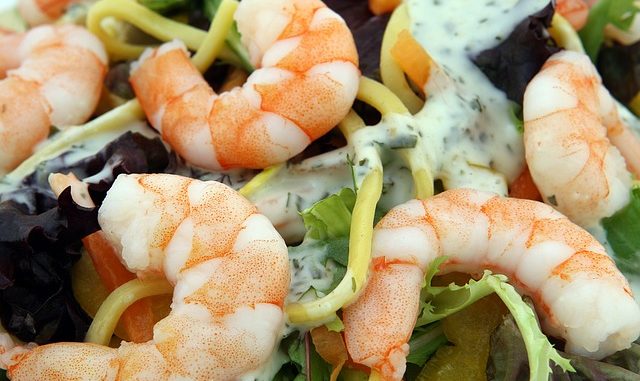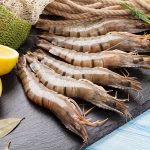
Pacific white shrimps are now the most widely grown cultivated shrimp in the world and with good reason. On a recent trip to the west coast of the USA it was obvious to any foodie that shrimp was plentiful and could be guzzled relatively cheaply. Linguine, prawn rolls, chowder have all succumbed to its charm. Local eateries from roadside cafes to upmarket restaurants along the California-Oregon coastline were offering starters and entrees with a pervasive whiff of garlic and white wine to really emphasize the sweetness of this mighty crustacean.
You might ask why pacific white shrimps are so popular ? Well for a start they are easy to grow and keep and they have a very rapid growth rate for such seafood – 120 days to be precise which means it takes just three months from hatching to harvesting. The two shrimps are large at 9 inches and rival their Atlantic cousin, the Gulf White Shrimp.
Two species living in sub-tropical to tropical warmwater are collectively called Pacific White shrimp. There is confusion over the genus names – the name Penaeus is often conflated with the alternative name, Litopenaeus. We have Penaeus vannamei, found from Sonora, Mexico, to northern Peru, and P. stylirostris, which ranges from Baja, California to Peru also. Most are collected in these seas by trawler but farmed shrimp has exploded as a commercial enterprise and many businesses now rely on this type of cultivation rather than collecting from the seas. Ecuador lays claim to being the farmed shrimp capital although in the USA, South Caroline through to Texas in a wide arch are also nipping at their heels. P. vannamei seems particularly popular in the farming community. China also loves P. vannamei and it is an important economic species in their aquaculture.
Farming offers a number of benefits to the consumer generally. There is better quality control for a start – it needs to be to prevent issues associated with seafood poisoning such as Vibriosis. There isn’t the time spent collecting and storing the shrimp either when it is trawled out at sea so it theoretically should be with us sooner and without the longer lead times of wild caught crustacea.
Processing of shrimp is also a consideration generally. Block freezing and IQF are the favoured methods so that the supply chain can be more versatile with all the processing costs passed directly to the end users such as the chefs. It does mean though that whilst we as customers and consumers pick up what is left of the tab, we are enjoying relatively cheaper food as a result. Processed shrimp can produce plenty of waste but there are moves to make the most of the chitin.
To minimise drip loss, peeled shrimps are usually dipped in phosphate solutions. This has been a long accepted practice but oversoaking can be problematic. Any thawed shrimp with a slightly ‘soapy’ texture has probably absorbed too much water because the soaking has been held too long. Dips need to be stated on all labels by the way.
General Nutrition
per 100g
| Calories: | 106 |
| Calories from fats: | 15.3 |
| Total Fat: | 1.7 g |
| Saturated Fat: | 0.3 g |
| Cholesterol: | 152 mg |
| Sodium: | 148 mg |
| Protein: | 20.3 g |
| Omega 3: | 0.53 g |
Shrimps whatever their species contain more cholesterol than any other type of seafood but they are lower in total and unsaturated fats than the equivalent quantity of meat and poultry.
Alternative Names
All these are used depending on which part of the Pacific they are farmed but see:- White-leg, Mexican white, Pacific white, Ecuadoran white; blue shrimp and steelies.
Sensory Profiles
Both white shrimp species have a clean, sweet and mild flavour, and also importantly retain their firmness with cooking. That’s key when cooking shrimp longer than usual in some broths. To many P. stylirostris has the saltier taste although it isn’t cut and dried. When they compare with the Gulf Whites in terms of looks, the Gulf species are a grey-white as compared to a creamy white when cooked. P. stylirostris actually takes on a white with greeny-blue tinge which is not unattractive in a shrimp. The raw meat of all species is white returning a slight pink tint when cooked.

Leave a Reply